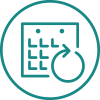
POCT D-dimer

POCT D-dimer
Purpose:
D-dimer is a Fibrin Degradation Product (FDP) used to determine whether clot formation has occurred or not. Its clinical application is as part of the diagnosis pathway for venous thromboembolic diseases: Deep Vein Thrombosis (DVT) and Pulmonary Embolism (PE).
NICE has recently reviewed its guidance on the diagnosis and management of venous thromboembolic disease advocating the use of Point of Care tests (POCT) in the event that a laboratory test is not immediately available.
- 1.1.12 When offering D-dimer testing for suspected DVT or PE, consider a point-of-care test if laboratory facilities are not immediately available. [2020]
- 1.1.13 If using a point-of-care D-dimer test, choose a fully quantitative test. [2020]
- 1.1.14 When using a point-of-care or laboratory D-dimer test, consider an age-adjusted D-dimer test threshold for people aged over 50. [2020]
NICE guidance states that if a D-dimer test cannot be obtained within 4 hours, interim anticoagulation should be given. If a person has a low likelihood of having a DVT, indicated by a Wells score of 1 or lower, then a negative D-dimer means there is no need for an ultrasound scan.
The diagnostic cut off is method dependent, however the majority of methods now report a cut off of ≥500 μg/L FEU for a positive D-dimer.
Scope:
Three samples are distributed bimonthly, with at least eighteen samples distributed annually. The panels consist of 6 endogenous pools, selected at D-dimer concentrations to cover negative, at or near the threshold and at a range of pathological concentrations. Each of the pools are distributed on 3 occasions over the year to assess both laboratory and method performance, including linearity, bias, within and between batch imprecision.
 |
Key Features:
|
| POCT D-dimer Programme | ||
|---|---|---|
| Analyte | Approx. Range Covered | |
| Quantitative D-dimer | 100 - 4000 | µg/L FEU |
| Qualitative D-dimer | Negative / Positive | |
Related Documents








